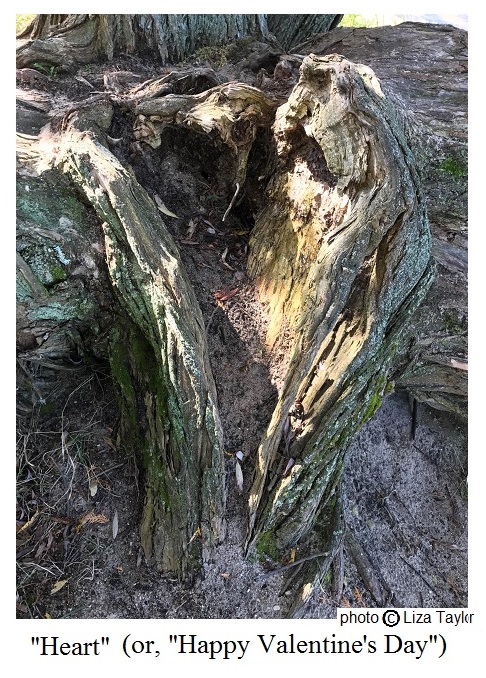
\


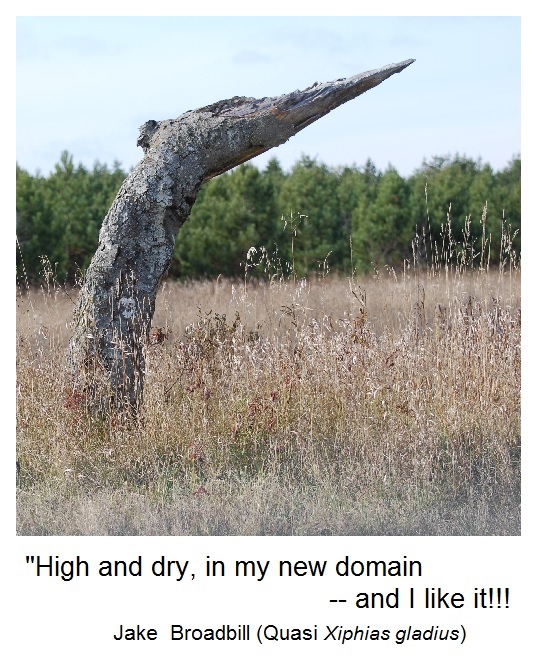

[
Interestingly, this one was located where Great Blue Herons are
frequently seen.]

[
This caption is based on my recollection of the myth about the "birth"
of a bird, the (H)alcyon, and its depictions, which resemble
today's kingfishers; the above wood form is similar to those
profiles. In addition, I thought about the present day
connotation of the adjective halcyon, especially its
widespread application to one's "golden years" -- i.e., the times
and/or places that are widely characterized by tranquility, peace and
prosperity; Consequently, the "west" part of the caption
is based on the
facing of the wood form and thoughts relating to the well-known 19th
century quotation "Go west, young man."
It seems of at least tangential interest, and
consequently noteworthy here, that the accepted scientific name of
several kingfishers
includes the generic term Halcyon, and the most
common North
American kingfisher, the belted kingfisher, has the species designation
alcyon.
]







[ The
above
photograph was taken during the fall of 2014. The below
photograph was taken during the spring of 2015. They were taken
from nearly, though not exactly, the same spot. In any case, the
later (i.e., spring) photograph shows a "clean shaven" Billy, and he's
lost beard. Both photographs are just as "he" appeared -- i.e.,
nothing shown or nearby was moved or removed; the photographs have not
been retouched.
This pair of
Nature's Wood Sculptures brought several things to mind: Perhaps
the most interesting is they reminded me that virtually all of the
features shown on this web site were formed as the results of what
seems well characterized as The RAVAGES of TIME and consequently are
short-lived. Indeed, they also led me to
indicate that some of photos that I take are by a Ph.Eph (photographer
of the
ephemeral). In any case, the R...ofT...
characterization led to several tangential thoughts -- considerations
about several of the diverse processes
that
are involved in the formation of these interesting "sculptures" and
wondering what modifications they will likely exhibit as they
deteriorate to ultimate
nothingness/nonexistence. To elaborate, one of the aspects that relates
to these forms and "The
RAVAGES of TIME" is the fate often referred to by the aphorism
"dust to dust" (see Genesis 3:19). ]

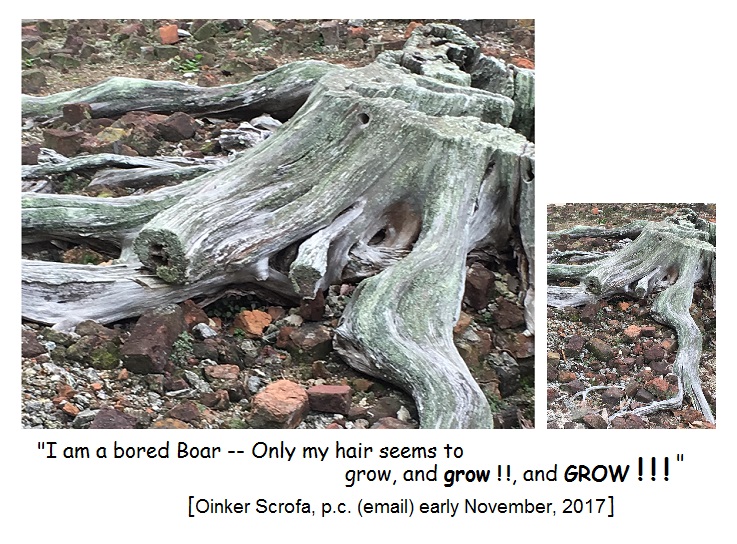
[ The
above
photograph was taken by my daughter, Krista D. Brown, near
Charleston, South Carolina in early November, 2017. The
designation Boar is hers; the rest of the caption is mine. ]







 ~ ~ & ~ ~
~ ~ & ~ ~
[
Orpheus
is widely
depicted with
a "golden" lyre. According to the
summary given in Wikipedia: "Poets such as Simonides
of Ceos said that Orpheus's music and singing could charm the birds,
fish and wild beasts, coax the trees and rocks into dance,
... and divert the course of rivers." ]
[ One wonders if the feature that is where Abraham's nose seems
to
belong may represent a locust. Also noteworthy: This "sculpture"
serves a dual role; it also is a small section of
the multi-wood forms image that appears in
the entry "High Tea." ]

[ with
apologies to
Edvard Munch: The
Scream (Norwegian:
Skrik, German: Der Schrei der Natur [i.e.,The scream of
Nature], which is said to have been Munch's title ]

[
The comic
strip
character Caspar
Milquetoast, a creation
of H.T. Webster, along with Gene Ahern's Major Hoople were
favorites of my youth! ]
[ This group
of three discarded pieces of Nature-shaped wood is shown just as
they lay when first viewed and photographed. When first seen,
this
group reminded me of Frans Hals' Laughing Cavalier.
Later, while cropping the overall photograph, the group seemed to
look more like what I think the spinster daughter in
Grant Wood's
American Gothic painting might have appeared had she
"dressed up" and donned a rather flamboyant hat and robe, before going
to
a High Tea. Whoever, the mass at her mouth has been
interpreted
differently by viewers -- e.g., her applying lipstick rather than a
sweet, buttered crumpet (my original thought). ]


[ SUGGESTIONS sent
by viewers:
"Mummified
Marsupial" "Deadeye (all dressed
up for the hootenanny)"
"Oh Dear! ..." ]
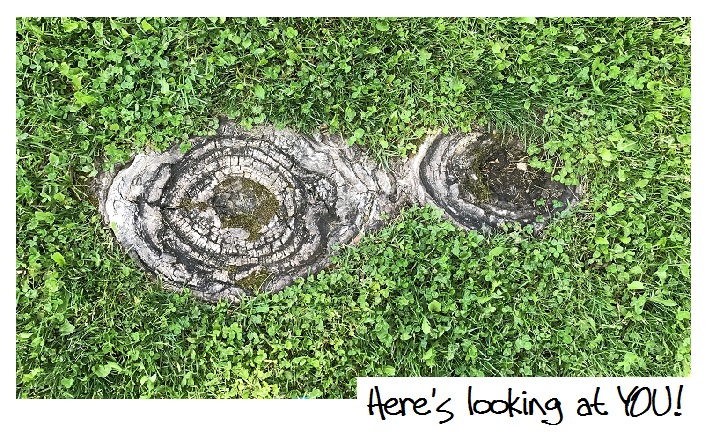
[ This fine
photograph © Liza Taylor. Alternative names
suggested: I'm looking at
YOU, A wink
(and a smile?) -- my favorite, The
EYEs really HAVE IT!, and
Owl eyes.]

[ This pair, parts
of the same "Sculpture," seem at odds. The wide-eyed one on the
right wants attention directed to its raised goatee as well as to its
raised eyebrows. ]


[ This "sculpture"
and, it appears especially, its title have led to several additional
thoughts, questions, ... -- for example: Does the
B.T. stand for Bed Time? ... for Big
Time? ... for Bad
Time? ... for . . . ? ? ? Actually, for none of
those! It is based on my recollections of nightmares I, and
several others, had each time after of some rather disturbing thingS
happened to one of our group ("civilians" ) because our sergeant
(regular army) seemed to need a "fall guy" while we were in Basic
Training during the
early 1940s in preparation for our WW-II service. ]

[ This "sculpture"
and the "title," which came to mind as soon as I saw the above
patterns,
reminded me of several things. In particular, I thought about
some of the lyrics of "Circles" -- e.g., ~"Nowhere to go and so
we spin around in circles, circles~" and also about two vocalists I
have
long admired -- Ella Fitzgerald and Malvina Reynolds: Ella's "
Whoa-ho-ho-ho-ho-ho" when she sang "The music goes round and
round"; Malvina's and my conversations about her "Little
Boxes..." (~"all made of ticky-tacky~") and spheres(circles) so many
people seem not to recognize as interdependent as well as important . . . .
(This was when Malvina was one of
the "headliners" at the first Earth Day demonstration, held on
April 22, 1970, at CMU.)
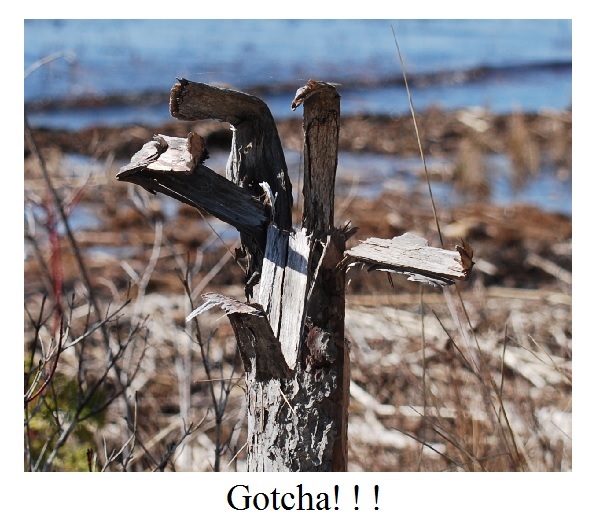
[ The "title" for this one
is a second choice. When I first saw the form, Pinwheel (as in fireworks) came to
mind. That name was based on recollections dating back to "The
Great Depression" (circa 1928-1932) when I wanted one or more of those
fireworks for the 4th of July
elebrations that we neighborhood "kids" had each year. I never
had one -- perhaps my Mom and Dad thought I might get powderburns
OR maybe it was to impress me with the fact
that each of those specialty fireworks cost more than a loaf of bread
in those days. ]

[ This "sculpture"
-- both viewing it and coming up with a caption was thought-provoking
as well as time-consuming, BOTH of which are good for one my
age who spends too much time on this, that, and whatever. -- most
of which is of little, if any, use or consequence. Among the
possible
captions that were considered for more than a few momemts were
"Contortionist" (thoughts of a friend at a place we
were stationed during WW-II), "Wrestling ..." (recollections of
'bout' with a
fellow freshman in s Colgate dormitory), "Holding
on" (several diverse stupid
'close calls' that I had while involved in
geological field work), "No(!), I SHAN'T...."
(a hope for anyone contemplating suicide ....), . . . And, of course, there also were
recollections of
Jack Haley (In "The Wizard of Oz").

[ This "sculpture,"
in part fashioned by woodpeckers led to one viewer to suggest the
alternative title "Hol[e]y, Hol[e]y, Hol[e]y."]
 [ BAD, UNhealthful
habits seem never to cease!!
[ BAD, UNhealthful
habits seem never to cease!! ]
~
~
& ~ ~



[
The pattern of the limbs of the birch tree, leafless during the winter,
is striking as set off by its background of evergreen trees. Its
location serves to direct attention to that pattern; one sees it while
going downgrade on a rather narrow, tree-lined road to the junction
with the main road of the area, part of which is shown in the
photograph. ]



[
These
are the roots
of a
hard
("sugar") maple tree, in St. Ignace that is thought to be more than 100
years old. ]

[ This one is hardly
a "sculpture." Instead it is one of Mother Nature's
prunings. An appropriate subtitle might be "A Westminster
would-be with its 'do'" -- i.e., its hairdo. Today (27 February '16),
the relationship is particularly interesting: As viewed from my
Living
Room, its movement with the wind closely resembles a show poodles' head
and 'do'while trotting aound the ring, with its leader, to exhibit its
gait. The more solid-appearing part of the head of thiis "Poodle"
consists of two evergreen cedars; its fluffed-up 'do' is the
leafless top of a maple. The overall relationship resulted from a
wind storm that removed, among
other
things, three nearby rather large cedar trees earlier this year. ]

[ This
one is an exception so far as the statement relating to the
"sculptures" in this album representing products of natural
processes. Quite obviously, its main part is a sawn
surface. A few others include such
surfaces, but those surfaces are NOT so-to-speak featured -- e.g., the
top of the fence post in "Knots" and the top of "A poochified stump?",
which are
the fifth and sixth photographs that follow this one. ]
[ The fungi on this
tree are widely referred to as Birch Bracket fungi or Birch
Polypore. When young, they are white (see two lower ones on right
photograph); with time, they become brown (see top one on right
and those in the left photograph). Especially in the past, these
fungi, when of appropriate age, were sometimes used for sharpening
razor blades; this led to another of their common names "Razor strop
fungus." Like the "artist's conk" fungus shown in Appendix
B, some well-aged Birch Bracket fungi have had artwork imposed on their
lower surfaces. ]


[ The shape of this
feature rather closely resembles the abstract shape of a gold pendant
once
being fashioned for
Frances, my wife for more than 60 years. It appears to be a thin,
inner layer of bark that has undergone incomplete drying, the
complementary shrivellng of which led to its current shape. ]
~
~
& ~
~
[
The above
knotty
pieces of
wood -- two horizontal, the other vertical -- led me to think
about "knotty problems" and
their resolution and also to two kinds of thinking:
Although
most of my efforts have involved vertical -- i.e.,
analytical -- thinking; I have enjoyed my ventures into
the
realm of, horizontal --i.e., imaginative -- thinking; But, in
many cases of both,
[
The four
small
photos, on the right, three of which have been rotated "make my
point."
[ This feature,
unlike most of those in this album, was not found not as the result of
accidental observations; it was, instead, found as the result
of much searching! -- Searching for a tree that would at least roughly
resemble the one
that is the focus in the mural by Per Krohg that is mentioned in the
Preface. A photograph of that mural is on the following web page:
http://www.alamy.com/stock-photo-The-City-Hall-Radhus-Oslo-Norway-The-East-Gallery-frescoed-by-Per-73455951.html
Unfortunately to date the one shown here is the best one yet
found. It shows a rather typical
multi-branched spruce treee whereas Krohg's tree was a diciduous tree
with only a few branches. Consequently, the search will contine.
In any case, when viewed from its bottom up, this felled tree also
exhibits an interesting rose-window-like pattern. SUGGESTIONS for
a caption include "Leaded
Window"
"Fireworks" (of the pinwheel
genre) "Spokes (presumably of
a bicycle) and
"Broken window/windshield" ]

[
More captions
have been suggested for the above
wood form than for any of the others.
The diversity is rather interesting -- e.g.,
"Agave" "Crown leaves of a Pineapple"
"Witch's
Broom" and "Shuttlecock". The one
given on the form was chosen because of the explanation supplied with
it.]
[ A
rather remarkable coincidence:
The day after the suggestion
"Flames" was made as a caption for this wood sculpture (left), my
daughter, Krista, sent me the photo that is shown on the right;
she had just taken it with her cell 'phone at their summer
home. AND,
she had neither seen the photograph on the left nor
heard
about the first listed suggested caption! ]
[
To
anser viewers' questions, "~What do you see on/in
this 'totem pole'?" --
Top
to bottom:
1. a dog or rodent (squirrel?);
2. a face -- right eye partly covered, oval mouth and goatee;
3. a large-eyed "Wow(ing)" character -- its
two "eyes" are about 40 per cent of the way below the top of the main
photograph;
4. the head of an elephant and/or, in part, a broad-billed "duck";
In addition, there are a few extraneous parts
of
"imaginary creatures."
]

[
One viewer suggested the caption "The flying horse of Kansu";
this,
interesting suggestion, rather well-based methinks, would have the
horse going right (Eastward, which seems quite appropriate!) rather
than towards the left. A second viewer saw
the arc as resembling a
"Wagon
wheel"; this would suggest
simplification of the given caption to "Westward Ho . . . " \
The
original caption was based on the perception that the arc portion
of this multifaceted "sculpture"
roughly resembles a simplified cross-section of a wave in a body
of water, and
the five pieces that
trend approximately 30 to 50 degrees from upper left to lower right
below the arc were seen to represent fishlike "creatures"
so-to-speak going along with, albeit just
below, the
wave's
surface. One viewer, who also "saw" this overall resemblance,
indicated that she saw at least two of these "creatures" as ducks,
grebes and/or loons or even porpoises rather than fish. ]

[
The original caption
involved the "person" whose profile constitutes the
~½ (i.e., the left side) of the upper part of this overall
wood "sculpture" and his/her looking down at the
reflection in the pool. Additional
SUGGESTIONS --
which relate to the identity of the "person" follow, and they are
given in the order most-to-least in the compiler's opinion to resemble
the
profile:
"Stan
Laurel, sad / agog"
"Ranger Smith of Jellystone Park" (the Yogi Bear cartoon, etc.)
Puppet
of the
Kookla,
Fran & Ollie TV show"
"Lamb
Chop" (sock puppet of ventriloquist Shari
Lewis) "Homer
Simpson" ]
~
~
& ~ ~
Appendix B. While looking
forward to the leafless trees period of the typical Fall season of the
area -- one of the times when one can see Nature's Wood "Sculptures"
nearly unobstructed, an early ~15-inch snowfall occurred. So
much for those anticipated views, at least for 2014. However,
several snow forms that roughly resemble such things as animals, both
real and fictional, and other diverse things were present,
apparently supported by the trees, both growing and downed by, for
example, windstorms.
The following composite shows a few of these that were present along a
county road near the north shore of Lake Michigan.

~
~
& ~ ~

















































